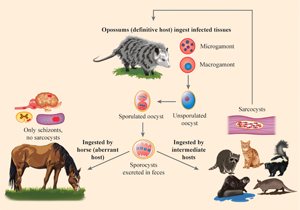Published online by Cambridge University Press: 09 March 2022

Sarcocystis neurona, Neospora spp. and Toxoplasma gondii are related protozoans; they were considered the same parasite until 1970s. Two of these parasites, S. neurona and Neospora spp. are associated with a neurological syndrome in horses, called equine protozoal myeloencephalitis (EPM). The diagnosis and treatment of EPM are difficult. Most cases of EPM are related to S. neurona while only a few are due to Neospora spp. infections. There are two species of Neospora, Neospora caninum that has a wide host range and Neospora hughesi that has been found only in horses. Currently, T. gondii is not considered as a cause of EPM in horses, although it causes neurological illness in many other hosts, including humans. The present review provides an update on history, life cycle, diagnosis and treatment of these three infections in horses.
*Dedicated to the memory of Dr William J. Saville, late professor, Department of Veterinary Preventive Medicine, The Ohio State University, Columbus, Ohio, USA, for his contributions to EPM.
To send this article to your Kindle, first ensure no-reply@cambridge.org is added to your Approved Personal Document E-mail List under your Personal Document Settings on the Manage Your Content and Devices page of your Amazon account. Then enter the ‘name’ part of your Kindle email address below. Find out more about sending to your Kindle. Find out more about saving to your Kindle.
Note you can select to save to either the @free.kindle.com or @kindle.com variations. ‘@free.kindle.com’ emails are free but can only be saved to your device when it is connected to wi-fi. ‘@kindle.com’ emails can be delivered even when you are not connected to wi-fi, but note that service fees apply.
Find out more about the Kindle Personal Document Service.
To save this article to your Dropbox account, please select one or more formats and confirm that you agree to abide by our usage policies. If this is the first time you used this feature, you will be asked to authorise Cambridge Core to connect with your Dropbox account. Find out more about saving content to Dropbox.
To save this article to your Google Drive account, please select one or more formats and confirm that you agree to abide by our usage policies. If this is the first time you used this feature, you will be asked to authorise Cambridge Core to connect with your Google Drive account. Find out more about saving content to Google Drive.